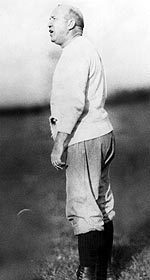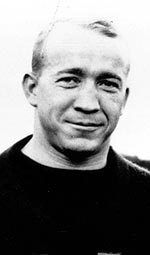March 27, 2006
Knute Rockne hasn’t coached a football game for 75 years, yet his legacy lives on all over the world.
Friday, March 31, 2006, marks the 75th anniversary of the death of the former University of Notre Dame football coach in a plane crash in Bazaar, Kan., and the anniversary will be marked — from Kansas to the Notre Dame campus to Norway — in a handful of ways, past, present and future:
* Near Bazaar, Kan., where Rockne’s plane went down, the Wichita (Kan.) Rockne Memorial Club will host a special memorial service at 10:00 a.m. CST, Friday, at the crash site.
Family members of the eight men who were killed in the crash will be on hand. Students, alumni, staff, friends, family and fans of Notre Dame and Rockne are invited to attend.
Free guided tours of the crash site (on private property) will be offered to the public and media (weather permitting) from 9:30 a.m.-noon on the 31st. Visitors are asked to meet at the Bazaar Schoolhouse, located seven miles south of Cottonwood Falls or eight miles north of Matfield Green on Highway 177.
The memorial service will include refreshments, a program on Rockne’s life and legacy presented by former executive director of the College Football Hall of Fame Bernie Kish, films on Rockne and the plane crash, and pictures and artifacts relating to the day. Among those sharing their recollections of the crash will be Easter Heathman, caretaker of the memorial marker and crash site for the past 75 years.
The Chase County Historical Museum in Cottonwood Falls will be open from 1:00 p.m. until 5:00 p.m. Artifacts from the plane and photographs taken the day of the crash are on display there.
* In Voss, Norway, Rockne’s birthplace, a statue of Rockne will be dedicated Friday at the exact time Rockne’s plane crashed into the Kansas hillside 75 years earlier.
The statue, sculpted by 1962 Notre Dame graduate Jerry McKenna, is identical to the one that was dedicated in March 2005 in front of the College Football Hall of Fame in South Bend.

Rockne coached from 1918 through 1930, finishing with a 105-12-5 (.881) career record that still ranks as the best winning percentage in the history of college football.
|
The molten bronze McKenna used to create the statue contained three particular elements – steel parts from Voss from a carriage made by Rockne’s father in 1888 (representing Knute Rockne’s birth), gold leaf from the golden dome at Notre Dame (representing Knute’s life at Notre Dame) and scraps of aluminum from the plane that crashed and carried Rockne to his death.
McKenna will be present in Voss for the dedication.
* On the Notre Dame campus, there will be multiple showings Friday of a 52-minute video documentary on Rockne titled, “Knute Rockne and His Fighting Irish” to recognize the anniversary of the Hall of Fame coach’s passing.
The video originally was shown on the PBS show “The American Experience.”
The video will be shown free of charge at 3:00, 4:00, 5:00 and 6:00 p.m. EST, at the Hesburgh Library Auditorium.
* McKenna also created a life-size bust of Rockne that was dedicated March 4 (Rockne’s birth date) in Rockne, an unincorporated Central Texas town of about 400 residents a dozen miles southwest of Bastrop, in a ceremony in the front yard of the Rockne Historical Association Museum.
Marian Nelson, president of the RHA, said she hopes the $20,000 bust lures visitors to the museum, which includes exhibits on the life of the German-Catholic community founded in 1846 and its namesake coach.
At the time, Rockne (the town) was called Hilbigville, after W.M. Hilbig, the owner of the town’s general store. Before that, it had been called Walnut Creek and Lehman. The community never had an official name, so in 1931 the parish priest at the only school in town, Sacred Heart Catholic, decided that the town’s children should vote on one. The choice for the town’s name was between two national icons, Rockne and poet Joyce Kilmer.
The vote was a tie, so the priest sent the children home to think about it. The next day, a student named Edith Ayers changed her vote. Ayers was very close to her father, and he was a big admirer of Rockne’s, so she changed her vote because it was something she could do to please her dad.
* From May 27 through Jan. 7, 2007, the Center for History in South Bend will offer the exhibit “Rockne: Crossing the Last Chalk Line.”
The exhibit will include a variety of Rockne artifacts and photos, an electronic field trip for students, an exhibit catalog and audio tour and a lecture series.
Among the artifacts that will be on display are a sweater and whistle used and worn by Rockne, a Rockne automobile developed by the Studebaker Corporation, a wristwatch worn by Rockne at the time of the crash — and a telegram from Rockne to his wife sent just before the plane took off that sent him to his death.
* Rockne is one of Notre Dame’s two representatives on the list of “100 Most Influential NCAA Student-Athletes” announced earlier this month in conjunction with the NCAA Centennial celebration in 2006.
The NCAA defines the 100 Most Influential Student-Athletes as those who have made a significant impact or major contributions to society. A special panel that included college presidents, athletics directors, faculty representatives, student-athletes and conference representatives chose the list.
Rockne was a receiver for the Notre Dame football team in 1912 and ’13, earning third-team All-America honors as a senior. He majored in chemistry, graduating magna cum laude with a grade average of 90.52 on a scale of 100.
As an undergraduate, Rockne worked as a chemistry research assistant in the laboratory of Rev. Julius A. Nieuwland, the renowned chemist who discovered the formula for synthetic rubber. Upon graduating, Rockne was offered a position at the University as a graduate assistant in chemistry, which he accepted on the condition that he be allowed to work as an assistant to football coach Jesse Harper.
When Harper retired after the 1917 season, Rockne was appointed head coach and Notre Dame’s football program soared to national prominence. He coached from 1918 through 1930, finishing with a 105-12-5 (.881) career record that still ranks as the best winning percentage in the history of college football. His teams won consensus national championships in 1924, 1929 and 1930, and he was inducted into the College Football Hall of Fame with the inaugural class in 1951.
Rockne died at age 43 in a plane crash March 31, 1931, in Bazaar, Kan.







